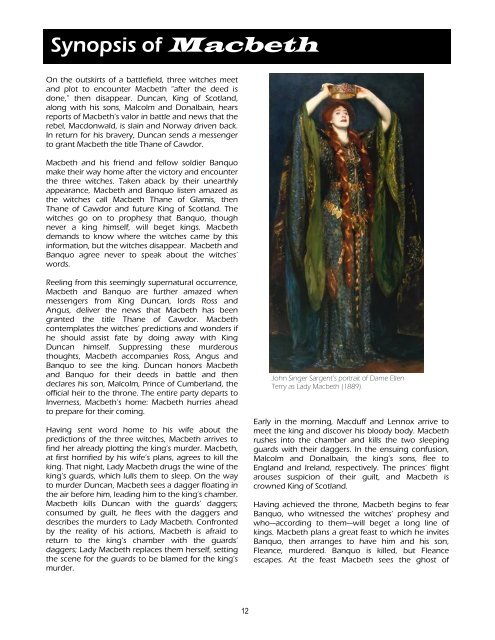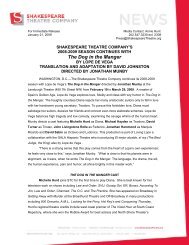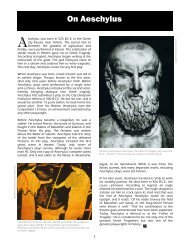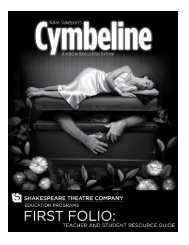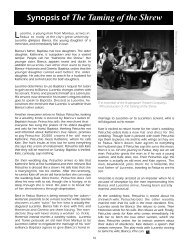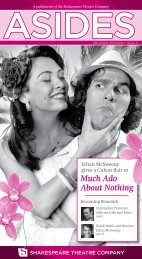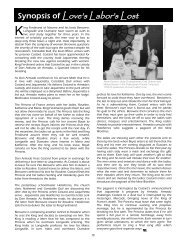Synopsis of Macbeth - The Shakespeare Theatre Company
Synopsis of Macbeth - The Shakespeare Theatre Company
Synopsis of Macbeth - The Shakespeare Theatre Company
Create successful ePaper yourself
Turn your PDF publications into a flip-book with our unique Google optimized e-Paper software.
<strong>Synopsis</strong> <strong>of</strong> <strong>Macbeth</strong><br />
On the outskirts <strong>of</strong> a battlefield, three witches meet<br />
and plot to encounter <strong>Macbeth</strong> “after the deed is<br />
done,” then disappear. Duncan, King <strong>of</strong> Scotland,<br />
along with his sons, Malcolm and Donalbain, hears<br />
reports <strong>of</strong> <strong>Macbeth</strong>’s valor in battle and news that the<br />
rebel, Macdonwald, is slain and Norway driven back.<br />
In return for his bravery, Duncan sends a messenger<br />
to grant <strong>Macbeth</strong> the title Thane <strong>of</strong> Cawdor.<br />
<strong>Macbeth</strong> and his friend and fellow soldier Banquo<br />
make their way home after the victory and encounter<br />
the three witches. Taken aback by their unearthly<br />
appearance, <strong>Macbeth</strong> and Banquo listen amazed as<br />
the witches call <strong>Macbeth</strong> Thane <strong>of</strong> Glamis, then<br />
Thane <strong>of</strong> Cawdor and future King <strong>of</strong> Scotland. <strong>The</strong><br />
witches go on to prophesy that Banquo, though<br />
never a king himself, will beget kings. <strong>Macbeth</strong><br />
demands to know where the witches came by this<br />
information, but the witches disappear. <strong>Macbeth</strong> and<br />
Banquo agree never to speak about the witches’<br />
words.<br />
Reeling from this seemingly supernatural occurrence,<br />
<strong>Macbeth</strong> and Banquo are further amazed when<br />
messengers from King Duncan, lords Ross and<br />
Angus, deliver the news that <strong>Macbeth</strong> has been<br />
granted the title Thane <strong>of</strong> Cawdor. <strong>Macbeth</strong><br />
contemplates the witches’ predictions and wonders if<br />
he should assist fate by doing away with King<br />
Duncan himself. Suppressing these murderous<br />
thoughts, <strong>Macbeth</strong> accompanies Ross, Angus and<br />
Banquo to see the king. Duncan honors <strong>Macbeth</strong><br />
and Banquo for their deeds in battle and then<br />
declares his son, Malcolm, Prince <strong>of</strong> Cumberland, the<br />
<strong>of</strong>ficial heir to the throne. <strong>The</strong> entire party departs to<br />
Inverness, <strong>Macbeth</strong>’s home: <strong>Macbeth</strong> hurries ahead<br />
to prepare for their coming.<br />
Having sent word home to his wife about the<br />
predictions <strong>of</strong> the three witches, <strong>Macbeth</strong> arrives to<br />
find her already plotting the king’s murder. <strong>Macbeth</strong>,<br />
at first horrified by his wife’s plans, agrees to kill the<br />
king. That night, Lady <strong>Macbeth</strong> drugs the wine <strong>of</strong> the<br />
king’s guards, which lulls them to sleep. On the way<br />
to murder Duncan, <strong>Macbeth</strong> sees a dagger floating in<br />
the air before him, leading him to the king’s chamber.<br />
<strong>Macbeth</strong> kills Duncan with the guards’ daggers;<br />
consumed by guilt, he flees with the daggers and<br />
describes the murders to Lady <strong>Macbeth</strong>. Confronted<br />
by the reality <strong>of</strong> his actions, <strong>Macbeth</strong> is afraid to<br />
return to the king’s chamber with the guards’<br />
daggers; Lady <strong>Macbeth</strong> replaces them herself, setting<br />
the scene for the guards to be blamed for the king’s<br />
murder.<br />
John Singer Sargent’s portrait <strong>of</strong> Dame Ellen<br />
Terry as Lady <strong>Macbeth</strong> (1889).<br />
Early in the morning, Macduff and Lennox arrive to<br />
meet the king and discover his bloody body. <strong>Macbeth</strong><br />
rushes into the chamber and kills the two sleeping<br />
guards with their daggers. In the ensuing confusion,<br />
Malcolm and Donalbain, the king’s sons, flee to<br />
England and Ireland, respectively. <strong>The</strong> princes’ flight<br />
arouses suspicion <strong>of</strong> their guilt, and <strong>Macbeth</strong> is<br />
crowned King <strong>of</strong> Scotland.<br />
Having achieved the throne, <strong>Macbeth</strong> begins to fear<br />
Banquo, who witnessed the witches’ prophesy and<br />
who—according to them—will beget a long line <strong>of</strong><br />
kings. <strong>Macbeth</strong> plans a great feast to which he invites<br />
Banquo, then arranges to have him and his son,<br />
Fleance, murdered. Banquo is killed, but Fleance<br />
escapes. At the feast <strong>Macbeth</strong> sees the ghost <strong>of</strong><br />
12
Banquo sitting at the table. <strong>The</strong> vision intensifies<br />
<strong>Macbeth</strong>’s already erratic behavior and Lady <strong>Macbeth</strong><br />
sends the lords away. Tormented by guilt and fearing<br />
for his future as king, <strong>Macbeth</strong> decides to visit the<br />
witches again.<br />
Some <strong>of</strong> the Scottish lords have begun to suspect<br />
<strong>Macbeth</strong>’s involvement in the murders. Macduff<br />
travels to England to meet with Malcolm, who has<br />
been taken in by King Edward (Edward the<br />
Confessor, 1042-66), in hopes that Edward will<br />
support Malcolm by sending an army headed by<br />
Siward, Earl <strong>of</strong> Northumberland. Upon learning <strong>of</strong> his<br />
flight, <strong>Macbeth</strong> sends murderers to surprise Macduff’s<br />
castle in his absence and kill his wife and children.<br />
Ross delivers this devastating news to Macduff in<br />
England. Macduff vows to avenge his family in battle<br />
with <strong>Macbeth</strong> and return the throne to Malcolm, the<br />
rightful heir.<br />
<strong>Macbeth</strong> returns to the witches who summon a series<br />
<strong>of</strong> apparitions with three warnings: first to beware<br />
Macduff, second that “none <strong>of</strong> woman born shall<br />
harm <strong>Macbeth</strong>” and third that <strong>Macbeth</strong> will never be<br />
defeated until Birnam Wood comes to Dunsinane<br />
(the location <strong>of</strong> <strong>Macbeth</strong>’s castle.) Feeling confident<br />
that the woods will never uproot and move<br />
themselves to his home, <strong>Macbeth</strong> returns to prepare<br />
for Malcolm’s attack. Back at the castle, Lady <strong>Macbeth</strong><br />
is walking and talking in her sleep. Her nurse<br />
summons a doctor and together they watch as Lady<br />
<strong>Macbeth</strong>, sleepwalking, relives the night <strong>of</strong> Duncan’s<br />
murder. As <strong>Macbeth</strong> prepares for war, Lady <strong>Macbeth</strong><br />
ends her life.<br />
Malcolm rallies the English forces and travels to<br />
Birnam Wood, where they are met by Scottish lords<br />
who have abandoned “the tyrant” <strong>Macbeth</strong>. To hide<br />
their number as they approach the castle, Malcolm<br />
instructs the army to cut branches from the forest and<br />
ride with them in front. <strong>Macbeth</strong> is horrified when a<br />
messenger tells him that Birnam Wood appears to be<br />
marching towards them. He dons his armor and<br />
prepares to fight, still convinced that none <strong>of</strong> woman<br />
born can hurt him. <strong>Macbeth</strong> meets Macduff on the<br />
battlefield and confesses this seeming infallibility, but<br />
Macduff tells him he was “from his mother’s womb<br />
untimely ripped.” Macduff defeats <strong>Macbeth</strong>, and<br />
Malcolm is restored to the throne.<br />
Four Lady <strong>Macbeth</strong>s: (clockwise from top left): Maggie Smith<br />
in the Stratford Festival production (1978), Judi Dench in the<br />
Royal <strong>Shakespeare</strong> <strong>Company</strong>’s film (1978), Francesca Annis<br />
in Roman Polanski’s film (1971), and Janet Suzman from a<br />
BBC production (1975).<br />
13
Changing <strong>of</strong> the Guard:<br />
England from Elizabeth to James<br />
Imperialism:<br />
<strong>The</strong> practice <strong>of</strong><br />
extending the<br />
power and<br />
wealth <strong>of</strong> a<br />
nation through<br />
territorial<br />
conquests.<br />
Spanish Armada:<br />
Fleet <strong>of</strong> ships<br />
launched by<br />
Philip II <strong>of</strong> Spain in<br />
1588 intended to<br />
conquer England.<br />
Elizabeth’s navy,<br />
led by Sir Francis<br />
Drake, defeated<br />
them soundly.<br />
Parliament:<br />
England’s<br />
legislative branch<br />
<strong>of</strong> government,<br />
similar to<br />
Congress in the<br />
United States.<br />
Queen Elizabeth I’s rule is <strong>of</strong>ten characterized as a time <strong>of</strong> glory, a time when England’s<br />
imperialism ruled the world and prosperity and success reigned. Under Elizabeth I, England<br />
defeated the Spanish Armada, sent settlers to America and maintained religious tolerance and<br />
peace. However, the end <strong>of</strong> Elizabeth I’s reign was plagued by an increasingly unstable economy<br />
and conflict with Ireland. <strong>The</strong>se problems became more apparent after King James I <strong>of</strong> Scotland<br />
inherited the throne, causing the people <strong>of</strong> England to look back to Elizabeth’s rule as the “golden<br />
years” in England’s history, marking James’ rule as one <strong>of</strong> darkness and corruption.<br />
Queen Elizabeth held <strong>of</strong>f choosing her successor until the very end <strong>of</strong> her life. Never having<br />
married and therefore having no heir, Elizabeth was the last legitimate descendant <strong>of</strong> King Henry<br />
VIII. When in 1603 it became apparent that the Queen was not going to recover from her<br />
sickness and an heir must be named, James VI, King <strong>of</strong> Scotland, was suggested, and Elizabeth is<br />
said to have made a gesture that showed her approval. Ironically, James was the son <strong>of</strong> Mary,<br />
Queen <strong>of</strong> Scots, who had been a constant threat to Elizabeth’s rule. Because <strong>of</strong> her ancestry (Mary<br />
was the granddaughter <strong>of</strong> Henry VIII’s sister and King James IV <strong>of</strong> Scotland), she felt she had a<br />
better claim to England’s throne than Elizabeth since King Henry VIII married Anne Boleyn,<br />
Elizabeth’s mother, after he divorced his first wife. Mary was a devout Catholic and did not believe<br />
in divorce; therefore, she viewed Elizabeth as an illegitimate child. Even though she posed a<br />
threat, Elizabeth held <strong>of</strong>f executing Mary until 1587, when it was discovered that she was<br />
associated with a plot to kill Elizabeth.<br />
When James I succeeded Elizabeth, he united the countries <strong>of</strong> Scotland and England in a peaceful<br />
manner. Elizabeth’s chief ministers had been planning for this event and smoothed the way for<br />
the new king’s arrival. His succession was uncontested even though there were objections that<br />
could have been raised—one being that King Henry VIII’s will could be interpreted as excluding<br />
the Scottish royalty from inheriting the English throne. <strong>The</strong> people <strong>of</strong> England were optimistic<br />
about their new king, but incidents such as the Gunpowder Plot <strong>of</strong> 1605, where Catholic<br />
dissenters contrived to blow up part <strong>of</strong> Parliament, cemented a climate <strong>of</strong> shock and suspicion<br />
around his rule. Elizabeth’s courtiers had flattered and admired her, but such actions only made<br />
James suspicious <strong>of</strong> possible hidden motives.<br />
<strong>The</strong> public’s view <strong>of</strong> their monarch greatly differed between Elizabeth and James. Queen<br />
Elizabeth’s public facade was carefully manipulated into one <strong>of</strong> power. Elizabeth reserved the<br />
right to destroy any portraits she deemed unacceptable, resulting in a carefully crafted image <strong>of</strong> a<br />
beautiful and powerful queen. In order to emphasize her importance, her portraits <strong>of</strong>ten showed<br />
her with symbolic images <strong>of</strong> her power. In one famous painting by George Gower, the Queen<br />
rests her hand on the globe and in the background there is a portrait <strong>of</strong> the Spanish Armada,<br />
alluding to England’s defeat <strong>of</strong> the Armada and its place in the world as an imperial power.<br />
Queen Elizabeth’s funeral procession, recorded in a series <strong>of</strong> drawings, took place on April 28th, 1603.<br />
14
Portrait <strong>of</strong> Queen Elizabeth by George Gower (c.1588-89)<br />
Whereas Elizabeth’s portraits positively influenced<br />
public opinion <strong>of</strong> the queen throughout her rule,<br />
James’ efforts to broaden his authority through the<br />
publication <strong>of</strong> his writings had neither the same control<br />
nor effect. Contrasted with Elizabeth’s limited and wellplanned<br />
forays into the public eye, James’ writings<br />
allowed the public extended knowledge <strong>of</strong> their ruler in<br />
a way that Elizabeth never permitted. Furthermore, by<br />
assuming a role as an author, James’ position as king<br />
was weakened. <strong>Shakespeare</strong>an scholar Dennis Kay<br />
writes, “Where Elizabeth had been celebrated by<br />
Edmund Spenser in <strong>The</strong> Faerie Queene … James diluted<br />
his royal magic by participating in the print<br />
culture” (124). Before gaining the crown in England,<br />
James had already published poetry and a treatise on<br />
kingship dedicated to his son. This Basilikon Doron<br />
(“King’s Gift”) focused on James’ belief in divine right—<br />
that Kings are appointed by God and therefore do not<br />
answer to anyone but Him. This belief led to many<br />
encounters with Parliament, who was concerned by<br />
James’ lack <strong>of</strong> consideration for its affairs and his<br />
extravagant disbursing <strong>of</strong> money and gifts.<br />
Parliament:<br />
England’s<br />
legislative branch<br />
<strong>of</strong> government,<br />
similar to<br />
Congress in the<br />
United States.<br />
Holinshed:<br />
In 1577, he<br />
published <strong>The</strong><br />
Chronicles <strong>of</strong><br />
England, Scotland<br />
and Ireland, a<br />
history <strong>of</strong> the<br />
region upon<br />
which<br />
<strong>Shakespeare</strong><br />
based many <strong>of</strong> his<br />
historical plays.<br />
In response to James’ excessive spending and its dissatisfaction with his rule, Parliament<br />
limited the King’s funds. A key reason for its dissatisfaction was James’ frequent practice <strong>of</strong><br />
awarding peerages or “landed titles.” While Elizabeth had always been wary <strong>of</strong> dispensing<br />
titles and money, James awarded more than 200 peerages during his reign as a way to<br />
gain loyalty and as rewards for those who gained his favor. This resulted in the decreasing<br />
importance <strong>of</strong> titles as common citizens could gain a title if they had the money to purchase<br />
one. King James also allocated money to support the arts. Patronage was necessary to<br />
acting companies <strong>of</strong> this time for them to be considered reputable. Under James’<br />
patronage, <strong>Shakespeare</strong>’s company became known as the King’s Men and thanked their<br />
king by performing a play, <strong>The</strong> Tragedy <strong>of</strong> Gowrie, based on an episode from his life.<br />
Some critics believe <strong>Shakespeare</strong>’s great tragedy <strong>Macbeth</strong> was written by royal command.<br />
Even if <strong>Shakespeare</strong> did not receive a specific order, the play definitely aimed to please King<br />
James, evidenced by the Scottish setting as well as the focus on witchcraft, a subject James<br />
explored in his own writing, Daemonologie. In Holinshed’s history Banquo is depicted as<br />
an accomplice to Duncan’s murder, but, as James<br />
claimed descent from Banquo, <strong>Shakespeare</strong> changed<br />
the character to one opposed to the killing.<br />
<strong>Shakespeare</strong>’s witches show an apparition <strong>of</strong> eight<br />
kings, all ancestors <strong>of</strong> Banquo and including King<br />
James I, supporting his right to the throne.<br />
1600-1608 is generally marked as the period during<br />
which <strong>Shakespeare</strong> wrote his great tragedies,<br />
including not only <strong>Macbeth</strong>, but also Hamlet, Othello<br />
and King Lear. It is significant that this period occurs<br />
during the crossover from the “Golden Rule” <strong>of</strong><br />
Queen Elizabeth to the troubled times <strong>of</strong> King James.<br />
It can be derived that the widespread dissatisfaction<br />
and problems during James’ rule revealed themselves<br />
in the rise <strong>of</strong> tragedies written by not only<br />
<strong>Shakespeare</strong> but also by Andrew Webster, Thomas<br />
Middleton and many other great writers <strong>of</strong> the early<br />
17th century.<br />
Portrait <strong>of</strong> James I (c.1610)<br />
15
Don’t Know Much About<br />
History...<br />
Clan:<br />
A large family<br />
group claiming<br />
descent from a<br />
common<br />
ancestor.<br />
Celtic:<br />
Descended from<br />
a group <strong>of</strong> early<br />
Indo-European<br />
settlers in<br />
Scotland, Ireland,<br />
Wales and Britain.<br />
Feudalism:<br />
Medieval system<br />
in which people<br />
were divided into<br />
strict social classes<br />
and land was<br />
divided into large<br />
manors, owned<br />
by a few lords.<br />
Scotland is a land <strong>of</strong> geographic variety, from the marshy lowlands <strong>of</strong> southern Scotland to<br />
the craggy highlands <strong>of</strong> the north. Despite Scotland’s lack <strong>of</strong> agricultural viability, battles<br />
have been waged over this territory since the first century AD. At that time, the clan-ruled<br />
Picts, descended from Scandinavian tribes to the northeast, inhabited the highlands. <strong>The</strong><br />
name Pict is derived from the Latin piclus, meaning “painted people,” because the Picts<br />
painted their bodies and faces. <strong>The</strong>ir Celtic neighbors to the south, the Scots, were mostly<br />
descended from Irish settlers. <strong>The</strong> Romans invaded and conquered the area now known as<br />
England in the first century. As they made their way north, the Romans were met with more<br />
and more resistance, particularly from the “barbaric” Picts. <strong>The</strong>y were eventually forced to<br />
abandon their advance northward. To keep the warlike tribes from invading Britannia (as<br />
the Romans named their newly conquered land), the emperor Hadrian had a massive wall<br />
erected from the east coast to the west, close to the border <strong>of</strong> present-day Scotland. <strong>The</strong><br />
ruins <strong>of</strong> Hadrian’s Wall are a modern-day tourist attraction.<br />
Over the next few centuries a growing rift developed between the Picts and the Scots. <strong>The</strong>ir<br />
proximity to England enabled the Scots to begin to adopt English culture and language.<br />
Feudalism was developed and trade increased. In the ninth century, Scottish king Kenneth<br />
MacAlpine united the Picts and Scots under his reign, and he and his descendants began to<br />
battle England for land near their shared border. By the time Duncan ascended the Scottish<br />
throne, eight generations later, Scottish territory had grown tremendously and included<br />
major portions <strong>of</strong> northern England. Duncan is the reigning king at the start <strong>of</strong><br />
<strong>Shakespeare</strong>’s <strong>Macbeth</strong>, though <strong>Shakespeare</strong>’s dramatization strays from documented<br />
Scottish history in a number <strong>of</strong> ways.<br />
Remnant <strong>of</strong> Hadrian’s wall as it stands today.<br />
Divine Right <strong>of</strong><br />
Kings:<br />
<strong>The</strong> law that the<br />
king <strong>of</strong> England<br />
was chosen by<br />
God.<br />
Ascendancy to the Scottish throne in the 11 th century was less formal than the strictly<br />
regulated rules <strong>of</strong> succession <strong>of</strong> its neighbor England, where the idea <strong>of</strong> Divine Right <strong>of</strong><br />
Kings stated that the current ruler was appointed by God, and anyone who removed the<br />
king from power was defying God’s will. In Scotland, which had a history <strong>of</strong> family-based<br />
clan rule, succession was loosely based on bloodlines; any man descended from a<br />
16
Engraving <strong>of</strong> the crowning <strong>of</strong> <strong>Macbeth</strong> from Holinshed’s Chronicles <strong>of</strong> England, Ireland and Scotland<br />
(1578).<br />
former king through his father or mother could conceivably claim the throne. In one <strong>of</strong><br />
<strong>Shakespeare</strong>’s sources for <strong>Macbeth</strong>, Raphael Holinshed’s <strong>The</strong> Historie <strong>of</strong> Scotland, King<br />
Duncan is described as “s<strong>of</strong>t and gentle <strong>of</strong> nature.” Most historians agree that this was<br />
Holinshed’s diplomatic way <strong>of</strong> describing a weak king, and in Medieval Scotland a weak king<br />
was not tolerated for very long. <strong>Macbeth</strong> had a decent claim to the Scottish throne: his<br />
mother was the daughter <strong>of</strong> King Kenneth II, and his wife, Gruoch (Lady <strong>Macbeth</strong>), was<br />
descended from Kenneth III. It was only natural that a great warrior with a royal heritage like<br />
<strong>Macbeth</strong> should usurp the throne from the weak Duncan.<br />
Canonization:<br />
To declare<br />
someone an<br />
<strong>of</strong>ficially<br />
recognized saint<br />
<strong>of</strong> the church.<br />
In <strong>Macbeth</strong>, as in most <strong>of</strong> his plays derived from historical sources, <strong>Shakespeare</strong> takes creative<br />
liberties with historical truth to “dramatize” the story. In many ways, <strong>Shakespeare</strong> does a<br />
disservice to the real <strong>Macbeth</strong>, who was a distinguished warrior and a competent ruler.<br />
Unlike their dramatic counterparts, <strong>Macbeth</strong> and King Duncan were pretty close in age, and<br />
<strong>Macbeth</strong> ruled for 17 fairly peaceful years, until Duncan’s son Malcolm returned from exile in<br />
England and defeated <strong>Macbeth</strong>. Malcolm was aided by his maternal grandfather, Siward Earl<br />
<strong>of</strong> Northumberland. <strong>The</strong> new King brought with him English practices and policies learned<br />
during his 17-year exile. In 1070, Malcolm married the English Princess Margaret, further<br />
strengthening ties with England. Margaret was very influential on her husband’s reign,<br />
helping him to develop an English-style parliament in Scotland, as well as forging strong ties<br />
between the Scottish church and the Roman Catholic Church. Margaret’s good deeds were<br />
recognized when she was canonized in 1250.<br />
Conflict with England began to build up during Malcolm’s reign; his marriage to Margaret<br />
gave him a fragile claim to the English throne, and he invaded Northern England with the<br />
hope <strong>of</strong> one day conquering the entire country. For 23 years Malcolm vacillated between<br />
invading England and making peace agreements with their king, William the Conqueror.<br />
Malcolm was finally killed in battle in 1093, but the wars between Scottish and English forces<br />
did not end. Malcolm’s ninth <strong>of</strong> 10 children, David I, continued his father’s crusades into<br />
England, claiming practically all <strong>of</strong> Northern England for Scotland by 1139. This land was<br />
soon lost by David’s young grandson Malcolm IV.<br />
Control <strong>of</strong> Scotland and Northern England fluctuated for over a century, until Scottish King<br />
Alexander III died and left as his heir the infant Margaret. Taking advantage <strong>of</strong> this obviously<br />
17
precarious situation, King Edward I <strong>of</strong> England suggested<br />
Margaret marry his son. <strong>The</strong> infant died before the marriage<br />
was made <strong>of</strong>ficial, and the Scottish throne was left without an<br />
heir. Thirteen different men claimed the crown, which went to<br />
John de Balliol, who was supported by King Edward. Later,<br />
when Edward asked for de Balliol’s assistance and was refused,<br />
the English King invaded Scotland. He stole the Stone <strong>of</strong> Scone,<br />
a sacred 340-pound rock on which all Scottish kings were<br />
crowned. England now had control <strong>of</strong> Scotland, though<br />
Edward met much resistance, particularly from two famous<br />
Scottish nationalists: William Wallace and Robert the Bruce.<br />
Wallace led the first strike against English forces, but was<br />
captured and executed in 1297 (these events are dramatized in<br />
the film Braveheart). Robert the Bruce was more successful,<br />
gaining independence for Scotland in 1328.<br />
Small skirmishes with England continued to plague Scotland’s<br />
border until 1603, when Scottish King James VI inherited the<br />
English throne from Elizabeth I, who died childless (a more<br />
complete description <strong>of</strong> James’ ascension to the throne can be<br />
found in the article “Changing <strong>of</strong> the Guard,” on page 14).<br />
England and Scotland were now indefinitely tied to the same<br />
monarch, and in 1707 the Act <strong>of</strong> Union joined them <strong>of</strong>ficially as<br />
Great Britain. In 1801, Ireland became part <strong>of</strong> what was now<br />
called the United Kingdom.<br />
Though Scotland is now a part <strong>of</strong> the larger nation Great<br />
Britain, it retains a sense <strong>of</strong> separate cultural identity, and a<br />
Mel Gibson as William Wallace in Braveheart (1995).<br />
Scottish Parliament was created in 1999 for a limited amount <strong>of</strong><br />
self-rule. Centuries <strong>of</strong> border conflict have not left Scotland<br />
unscathed, however: the gradual adoption <strong>of</strong> many English<br />
customs and traditions has practically obliterated remnants <strong>of</strong> Pictish culture and history,<br />
and there remains a band <strong>of</strong> Scottish nationalists vying for an independent kingdom.<br />
Engraving <strong>of</strong> the three witches from <strong>Macbeth</strong> from Holinshed’s Chronicles <strong>of</strong> England, Ireland and<br />
Scotland (1578).<br />
18
<strong>Macbeth</strong><br />
and Masques<br />
During the reign <strong>of</strong> James I, theatrical styles and<br />
tastes changed rapidly as the king’s personal taste for<br />
elaborate, decorative and highly stylized<br />
presentations inspired the creation <strong>of</strong> a new<br />
theatrical medium—the masque. Developed from the<br />
early 16th-century "disguising," or "mummery," in<br />
which disguised guests bearing presents broke into a<br />
festival and joined with their hosts in a ceremonial<br />
dance, masques eventually evolved to include the<br />
use <strong>of</strong> the mask and the mingling <strong>of</strong> actors and<br />
audience. <strong>The</strong> Jacobean masque introduced a party<br />
or festival atmosphere to the performance and<br />
included elaborate sets and costumes for both<br />
performers and audience. Masque reached its height<br />
<strong>of</strong> popularity during the reign <strong>of</strong> James I in the early<br />
17th century, evolving into huge events <strong>of</strong><br />
spectacular and colorful spectacles presented in<br />
public theatres and, with even more splendor, at the<br />
royal court. <strong>The</strong> actors <strong>of</strong>ten played pastoral or<br />
mythological characters, with a great significance<br />
placed on music and dancing.<br />
Masques also became presentations in which<br />
important political or social issues <strong>of</strong> the time were<br />
discussed, including race, religion and colonization.<br />
<strong>The</strong> most prolific writer <strong>of</strong> masques was Ben Johnson,<br />
<strong>Shakespeare</strong>'s contemporary, who wrote plays such<br />
as <strong>The</strong> Masque <strong>of</strong> Blackness, which discussed issues<br />
<strong>of</strong> race and England's colonization <strong>of</strong> native peoples<br />
in exotic places. This masque focused on the journey<br />
<strong>of</strong> the people <strong>of</strong> Niger to find a more suitable "sun"<br />
and was supposedly written by Jonson in response to<br />
a desire by Queen Anne, James I's wife, to play a<br />
black woman on stage. <strong>The</strong> "sun" that the people<br />
pursue in the masque is believed to be both an<br />
analogy for Christianity, as the native people pursue<br />
this new "son" <strong>of</strong> God, and the son or chosen <strong>of</strong> God ,<br />
as represented by King James himself. This masque<br />
complimented the King but also celebrated the<br />
beauty and power <strong>of</strong> the wondrous and, to the<br />
English, strange people <strong>of</strong> Niger. It also served as an<br />
argument for colonization, suggesting England was<br />
correct to spread its Christianity and culture around<br />
the globe. Ben Jonson's collaborator Inigo Jones<br />
created elaborate costumes, settings and scenic<br />
effects for all <strong>of</strong> his masques, including this one, and<br />
therefore was the one most responsible for making<br />
the masque so spectacular and popular during<br />
James' reign. This masque was no exception and,<br />
although it included throngs <strong>of</strong> actors, musicians,<br />
costumes, sets and amazing effects, and therefore<br />
<strong>Macbeth</strong> Consulting the Vision <strong>of</strong> the Armed Head. Henry<br />
Fuseli (1741).<br />
required somewhere between £1,000 and £3,000 to<br />
produce, it was performed only once. Spectacle and<br />
extravagance became the fashion <strong>of</strong> the day.<br />
As a tribute to King James I's Scottish background,<br />
<strong>Macbeth</strong> was perhaps first presented for the King in<br />
1606 on the occasion <strong>of</strong> a visit from his brother-in-law,<br />
Christian IV <strong>of</strong> Denmark. By this time <strong>Shakespeare</strong>'s<br />
company had royal patronage and was known as the<br />
King's Men; they therefore created a play paying<br />
tribute to Scottish history that honored the ancestry <strong>of</strong><br />
the King. <strong>The</strong> role <strong>of</strong> <strong>Macbeth</strong> was originally played by<br />
<strong>Shakespeare</strong>'s lead actor Richard Burbage and Lady<br />
<strong>Macbeth</strong> by the boy-actress named Edmans. Aware <strong>of</strong><br />
James' penchant for spectacular shows, music and<br />
dances, <strong>Shakespeare</strong>’s company included elements <strong>of</strong><br />
the masque within <strong>Macbeth</strong> but may have hired<br />
someone else to actually write them. In fact, evidence<br />
suggests the lyrical passages in <strong>Macbeth</strong> dealing with<br />
the witches were in fact written by Thomas Middleton<br />
(1580-1627), a younger contemporary <strong>of</strong><br />
<strong>Shakespeare</strong>'s. Middleton specialized in writing songs<br />
and dances and eventually would write a play called<br />
19
<strong>The</strong> Witch in 1610, in which Hecate (the leader <strong>of</strong> the<br />
witches in <strong>Macbeth</strong>) appears and performs two songs<br />
originally found in <strong>Macbeth</strong>. Some scholars suggest<br />
that Middleton was attempting to create a musical<br />
version <strong>of</strong> <strong>Macbeth</strong> and that the Hecate scenes are a<br />
remnant <strong>of</strong> that. Some argue that the difficulty <strong>of</strong><br />
playing <strong>Macbeth</strong> and the fact that it is <strong>Shakespeare</strong>'s<br />
shortest tragedy prove that there are more songs and<br />
dances that have since been lost. <strong>The</strong> play first<br />
appeared in publication in the First Folio <strong>of</strong> 1623,<br />
where it showed some symptoms <strong>of</strong> having already<br />
been cut and edited. James' fear <strong>of</strong> witches and the<br />
historical suggestion that the real <strong>Macbeth</strong> had in<br />
some way consulted with the supernatural during his<br />
reign gave <strong>Shakespeare</strong> a great excuse to include<br />
some spectacular songs and dances to please his<br />
King.<br />
With the knowledge that this play was inspired by<br />
the masque and probably originally intended to be<br />
performed in that style before the King, it would be<br />
imprudent to play <strong>Macbeth</strong> without a nod to the<br />
spectacle and extravagance <strong>of</strong> the Jacobean<br />
masques. A play that includes witches, ghosts and<br />
supernatural spirits demands the fantasy and magic<br />
in which <strong>Shakespeare</strong> wishes us to believe.<br />
Costume sketch <strong>of</strong> a knight by Inigo Jones.<br />
Elizabethan Style <strong>of</strong> <strong>The</strong>atre<br />
1558-1603<br />
No elaborate sets; open, bare stage; minimal<br />
special effects.<br />
Actors perform in open-air theatre on a<br />
stage separated from most audience<br />
members.<br />
Production costs are kept to a minimum to<br />
increase pr<strong>of</strong>its; plays are performed multiple<br />
times if popular to sell more tickets.<br />
<strong>Shakespeare</strong> writes Romeo and Juliet, A<br />
Midsummer Night’s Dream and Hamlet.<br />
Heightened language and fantastic<br />
storytelling are the focus <strong>of</strong> seeing theatre.<br />
Jacobean Style <strong>of</strong> <strong>The</strong>atre<br />
1603-1625<br />
Elaborate settings including live animals,<br />
waterfalls and amazing special effects.<br />
Throngs <strong>of</strong> extra actors perform and dance<br />
amongst audience members with no<br />
separation between them.<br />
Production costs are so high and spectacular<br />
shows so expensive that most masques are<br />
performed only once.<br />
<strong>Shakespeare</strong> writes King Lear, <strong>Macbeth</strong> and<br />
<strong>The</strong> Winter’s Tale.<br />
Amazing spectacle and extravagant<br />
productions are the focus <strong>of</strong> seeing theatre.<br />
20
Something<br />
Wicked<br />
This Way Comes...<br />
Before the advent <strong>of</strong> modern medicine to explain the<br />
diseases <strong>of</strong> the body, witchcraft, omens and spells<br />
controlled the daily lives <strong>of</strong> many <strong>of</strong> the inhabitants <strong>of</strong><br />
<strong>Shakespeare</strong>'s London. As populations increased, new<br />
outbreaks <strong>of</strong> disease proliferated, and the Church <strong>of</strong><br />
England continued to wrestle with Catholicism for<br />
religious supremacy in England, new superstitions and<br />
mass hallucinations appeared almost daily. <strong>The</strong> diseases<br />
<strong>of</strong> insanity and hypochondria were believed to be<br />
afflictions <strong>of</strong> the devil; stories abounded <strong>of</strong> men who<br />
sometimes believed they were wolves and fled into the<br />
mountains, nuns who imagined they were cats, maidens<br />
who vomited pins and men who believed they had<br />
snakes in their intestines. <strong>The</strong> fanatical and fantastical<br />
remedies for such illnesses included rubbing "magic<br />
ointment" on the skin to produce dreams or drinking<br />
water out <strong>of</strong> a murdered man's skull. In the midst <strong>of</strong> all<br />
this confusion and superstition, Elizabethans struggled<br />
to find something substantial to blame for these<br />
mysteries. Witchcraft quickly became the primary target<br />
A Cemetery, from Hans Holbein’s series<br />
Dance <strong>of</strong> Death (1538).<br />
as a practice believed to be capable <strong>of</strong> ruling the fates <strong>of</strong> men. <strong>The</strong> witches in <strong>Macbeth</strong> are referred<br />
to as the "weird" sisters, from the Anglo-Saxon word wyrd meaning "fate." Having been familiar<br />
with witches and their powers all their lives, <strong>Shakespeare</strong>'s audience would have understood and<br />
perhaps believed that these three women could shape and decide <strong>Macbeth</strong>'s fate.<br />
Midwife:<br />
A woman who<br />
assisted with<br />
childbirth, gaining<br />
her skills from<br />
experience and<br />
lore passed down<br />
through<br />
generations.<br />
Familiars:<br />
A spirit embodied<br />
in an animal.<br />
Bubonic Plague:<br />
Disease, also<br />
called the Black<br />
Death, that<br />
wiped out 3/4 <strong>of</strong><br />
Europe in<br />
<strong>Shakespeare</strong>’s<br />
time.<br />
In <strong>Shakespeare</strong>'s London witches were<br />
real and seen on the streets every day.<br />
Often men and women who lived on<br />
the fringes <strong>of</strong> their society, "witches"<br />
became easy scapegoats for any<br />
accidents, illnesses or deaths in their<br />
towns or villages. Midwives were <strong>of</strong>ten<br />
considered witches because <strong>of</strong> their<br />
natural remedies and understandings <strong>of</strong><br />
the female body. In fact, as early as<br />
1487, the practices and beliefs <strong>of</strong><br />
witchcraft were associated almost<br />
entirely with women and recorded in<br />
Malleus Malificarum (1486), a document<br />
accepted by the church claiming that<br />
"all witchcraft comes from carnal lust,<br />
<strong>The</strong> Three Witches. Henry Fuseli (1783).<br />
which in women is insatiable." In 1508,<br />
Maximilian Johannes produced<br />
Antiphonus Maleficiorum, which established withcraft as fact and taught Christians how to defend<br />
themselves against it. <strong>The</strong> "black magic" activities <strong>of</strong> witches ranged from the silly to the horrific.<br />
<strong>The</strong>y were believed to sometimes keep beer from fermenting or butter from hardening; sometimes<br />
they forced men and women to commit adultery; they had the power to prevent women from<br />
getting pregnant as well as cause miscarriages or stillbirths.<br />
Witches were believed to have sold their souls to the devil and, in return, to have received animal<br />
companions or "familiars," (named for the Latin word "famulus" meaning servant) who would do<br />
their bidding and carry out some <strong>of</strong> their nastier tricks. Often these "familiars" were believed to be<br />
black cats or toads. In <strong>Macbeth</strong>, the "Graymalkin" and "Paddock" referred to by the witches in the<br />
first scene are believed to be a cat and toad. Ironically, the continual persecution and destruction<br />
<strong>of</strong> witches and their cats during <strong>Shakespeare</strong>'s time helped to speed the spread <strong>of</strong> diseases like the<br />
Bubonic Plague. Jacobeans did not realize rats carried the majority <strong>of</strong> these diseases and<br />
undervalued the presence <strong>of</strong> cats to destroy these rats.<br />
21
Although some witches did practice the "black arts"<br />
and believed they could curse and disease others,<br />
many accused witches were simply helpless<br />
innocents. Often a solitary woman such as a widow<br />
or homeless woman would become <strong>of</strong>fended by<br />
another member <strong>of</strong> her society and be heard to<br />
mutter curses at that person under her breath.<br />
<strong>The</strong>n, when the "cursed" person experienced any<br />
hardship or disease (which was extraordinarily<br />
common in this age before personal hygiene), they<br />
would blame the "witch" and have her either jailed<br />
or hung. Some witches created disgusting mixtures<br />
<strong>of</strong> ingredients meant to either cure or curse their<br />
patient or victim. Hair, saliva, blood and animal<br />
entrails <strong>of</strong>ten went into their potions, while some<br />
mixtures, similar to the ones in <strong>Macbeth</strong>, actually<br />
contained many herbs and other plant life that<br />
were used as early medicines. Most witches were<br />
wise women and men who knew a great deal<br />
about holistic medicine and were <strong>of</strong>ten called upon<br />
instead <strong>of</strong> doctors to cure physical ailments with<br />
potions and "tricks." As long as their patients were<br />
cured, they were considered "white" witches or<br />
wizards. If a patient died, however, they were<br />
persecuted as "black" witches and therefore evil.<br />
Obviously, in an age before modern medicines, the<br />
guarantee that witches could cure someone <strong>of</strong> a<br />
disease was shaky at best. <strong>The</strong> fate <strong>of</strong> being<br />
associated at least once with someone who died<br />
was guaranteed. Ironically, some <strong>of</strong> their successes<br />
at curing patients with herbs and natural remedies<br />
helped to lead to their demise, as the maledominated<br />
English society sought to purge this<br />
female-dominated practice. In 1541 Henry VIII<br />
passed the first act against sorcery and magic; in<br />
1562 the law was revived, and by <strong>Shakespeare</strong>'s<br />
time the active persecution <strong>of</strong> witches was a part <strong>of</strong><br />
daily life. When Queen Elizabeth I died and James I<br />
became king, witches faced a new and powerfully<br />
paranoid opponent.<br />
During the rein <strong>of</strong> James I, witch hunts became<br />
more and more popular. A self-proclaimed expert<br />
on witchcraft, James was notoriously fearful <strong>of</strong><br />
women and therefore especially afraid <strong>of</strong> witches.<br />
Women in London during James' reign began<br />
behaving and dressing more "male," wearing their<br />
hair shorter, their doublets pointed and their hats<br />
with broader brims. <strong>The</strong>se changes were in part a<br />
reaction to the more feminine dress <strong>of</strong> the men,<br />
inspired by James himself, and to the strong and<br />
still echoing image <strong>of</strong> their late Queen Elizabeth,<br />
who <strong>of</strong>ten appeared in portraits dressed in armor<br />
or other traditionally "male" clothes. James ordered<br />
the clergy <strong>of</strong> London to include sermons chastizing<br />
women to wear more feminine fashions. James<br />
feared that witches were plotting to kill him and,<br />
indeed, several assassination attempts during his<br />
reign involved witchcraft or "magical potions."<br />
<strong>The</strong> Old Woman, from Hans Holbein’s series Dance <strong>of</strong><br />
Death (1538).<br />
In 1597, James published Daemonologie, his book on<br />
witchcraft in which he described his belief in witches<br />
and their practices; advocating for the swift<br />
destruction <strong>of</strong> any discovered witches. Women and<br />
men accused <strong>of</strong> witchcraft were therefore put<br />
through ridiculous trials to test if they were truly<br />
witches, resulting in the deaths <strong>of</strong> thousands <strong>of</strong><br />
innocent people. One common practice was to tie a<br />
stone to the witch and throw her in the river. If she<br />
floated to the top she was a witch; if she sank to the<br />
bottom she was innocent. <strong>The</strong> only true way to kill a<br />
witch was burning, leading to many public burnings<br />
<strong>of</strong> innocent women and men under James' rule. After<br />
James' death, the persecution <strong>of</strong> witches slowly died<br />
out in England. <strong>The</strong> belief in witches, however,<br />
would ultimately travel to the New World, leading to<br />
the Salem Witch Hunts in Massachusetts and<br />
resulting in many more deaths in America before this<br />
fanatical fear <strong>of</strong> witchcraft finally came to an end in<br />
the 18 th century. In <strong>Macbeth</strong>, <strong>Shakespeare</strong> reminds us<br />
<strong>of</strong> times both in medieval Scotland and Jacobean<br />
England when witches inspired terror in a powerful<br />
king and helped to guide the decisions <strong>of</strong> an entire<br />
nation.<br />
22
<strong>Macbeth</strong>:<br />
Adapted<br />
As <strong>Shakespeare</strong> set pen to paper in the early 17th century to scrawl the first lines <strong>of</strong> <strong>Macbeth</strong>, he<br />
probably didn’t think that audiences 400 years later would still be enjoying his work. Even though<br />
<strong>Macbeth</strong> is rooted in the history <strong>of</strong> Scotland, film and theatre-makers have created whole new<br />
worlds for the play, sometimes using <strong>Shakespeare</strong>’s text, and sometimes writing a new script based<br />
on the story. Adaptations can make <strong>Shakespeare</strong>’s classic texts fresh and exciting by connecting<br />
modern audiences and different cultures to the themes <strong>of</strong> the play.<br />
James I:<br />
King <strong>of</strong> England,<br />
1603-1625.<br />
James sponsored<br />
<strong>Shakespeare</strong>’s<br />
acting company,<br />
the King’s Men.<br />
On the Stage<br />
When Charles II, James I's grandson, took the throne <strong>of</strong> Britain in 1660, he assigned the role <strong>of</strong><br />
<strong>Macbeth</strong> to William Davenant and the Duke's <strong>Company</strong>. Davenant altered the work considerably<br />
to indulge his two favorite hobbies: operatic scenic splendor and structural balance. He elaborated<br />
the witches' scenes, introducing all kinds <strong>of</strong> dancing, singing and gibberish, some <strong>of</strong> it taken from<br />
Middleton's <strong>The</strong> Witch. He also expanded the role <strong>of</strong> Lady Macduff, creating numerous scenes<br />
between her and her lord symmetrically opposed to the bits between <strong>Macbeth</strong> and his ambitious<br />
wife. Macduff's virtuous lady persuades him away from ambition. Lady <strong>Macbeth</strong> is given a new<br />
scene in which she is haunted by the ghost <strong>of</strong> Duncan, which convinces her to persuade <strong>Macbeth</strong><br />
to give up ambition and the crown. Davenant's "adaptation," with Thomas Betterton in the title<br />
role, was preferred by audiences and drove <strong>Shakespeare</strong>'s original from the stage until 1744.<br />
<strong>The</strong> famous actor David Garrick, during his management <strong>of</strong> the Drury Lane <strong>The</strong>atre (1742-1776),<br />
revived <strong>Macbeth</strong> as written by <strong>Shakespeare</strong>, playing the title role. Although Garrick retained<br />
Davenant’s operatic witch scenes, he cut the extra scenes with Lady MacDuff as well as her<br />
original murder scene (IV, 2) and the Porter scene (II, 3). He wrote a new climactic speech for<br />
<strong>Macbeth</strong>, in which the hero-villain mentions, with his dying breath, his guilt, delusion, the witches<br />
and horrid visions <strong>of</strong> future punishment, ushering in the contemporary habit <strong>of</strong> trying to justify<br />
<strong>Macbeth</strong>'s killing. Garrick and his leading lady, Hannah Pritchard, introduced a natural style <strong>of</strong><br />
acting and became famous as the tortured hero and heroine. Supposedly, Garrick's performance<br />
was so convincing that one night when he told the First Murderer, "<strong>The</strong>re's blood upon thy face,"<br />
the actor involuntarily replied, "Is there, by God?"<br />
Throughout the next 200 years many acting couples became famous playing the <strong>Macbeth</strong>s, each<br />
couple contributing its own interpretation <strong>of</strong> <strong>Shakespeare</strong>'s work, including different reactions to<br />
Banquo's ghost and several variations on Lady <strong>Macbeth</strong>'s mad scenes. It was not until the 19th<br />
century that <strong>Shakespeare</strong>'s play returned to the stage in its original form. Samuel Phelps (1804-<br />
1878) is credited with stripping <strong>Macbeth</strong> <strong>of</strong> the accumulated adaptations and amendations during<br />
his management <strong>of</strong> Sadler's Wells in London between 1844 and 1862. Unlike his contemporaries,<br />
who rearranged the play to avoid scene shifts and made drastic cuts to allow scope for spectacle,<br />
Phelps made only minor cuts to the play.<br />
Crowding the streets <strong>of</strong> Harlem for Orson Welles’ 1936 production <strong>of</strong><br />
<strong>Macbeth</strong>.<br />
23<br />
<strong>The</strong> 20th century saw several great revivals,<br />
including Orson Welles' <strong>Macbeth</strong> at the Lafayette<br />
<strong>The</strong>atre in Harlem (1936), which began his directing<br />
career. <strong>The</strong> production was set in 19th-century Haiti<br />
with an entirely African-American cast<br />
(revolutionary at the time.) This federally funded<br />
project transported the Scottish play to a vibrant<br />
Haitian jungle in which the witches played voodoo<br />
drums and the court swayed to waltzes in their<br />
colorful costumes. Welles’ use <strong>of</strong> voodoo as the<br />
magic <strong>of</strong> the play made the Elizabethan belief in<br />
witches as servants <strong>of</strong> the devil more immediate to<br />
contemporary audiences. Ten thousand people<br />
jammed the streets <strong>of</strong> Harlem for 10 blocks past the<br />
theatre on opening night, trying to catch a glimpse<br />
<strong>of</strong> this wild production.
In 2004, the Perseverance <strong>The</strong>atre <strong>of</strong> Alaska explored the world <strong>of</strong> <strong>Macbeth</strong> set in an entirely<br />
different culture. Director Anita Maynard-Losh set the play within the culture <strong>of</strong> the Tlingit people,<br />
the indigenous people <strong>of</strong> Southern Alaska. Through the text <strong>of</strong> <strong>Shakespeare</strong>, she explored the<br />
similarities between the cultures <strong>of</strong> the clans <strong>of</strong> Scotland and the clans <strong>of</strong> the Tlingit through<br />
drumming, dance, masks and images <strong>of</strong> the Tlingit tradition. <strong>The</strong> audience viewed an adaptation<br />
<strong>of</strong> <strong>Macbeth</strong> that communicated its themes through the shared cultural history <strong>of</strong> the region.<br />
Stage adaptations <strong>of</strong> <strong>Macbeth</strong> also have been politically motivated, not always strictly adhering to<br />
<strong>Shakespeare</strong>'s text. Barbara Garson was inspired to write MacBird! during a 1965 anti-war rally<br />
protesting the war in Vietnam. In the middle <strong>of</strong> this protest, the first line <strong>of</strong> her play just came to<br />
her: “When shall we three meet again / in riot, strike, or stopping train?” <strong>The</strong> play takes place at<br />
the 1960 Democratic Presidential convention. <strong>The</strong> lead character is an ambitious man named<br />
MacBird, a thinly veiled Lyndon B. Johnson, who is forced to take the Vice Presidential nomination<br />
even though he wanted to be President. Lady MacBird, his wife, is a reference to Lady Bird<br />
Johnson. <strong>The</strong> character who gets the presidential nomination is named John Ken O’Dunc<br />
drawing an analogy between Duncan, the assassinated king in the play, and John F. Kennedy, the<br />
assassinated American president. As the play progresses, John Ken O’Dunc is murdered and the<br />
MacBirds gain power, only to have to deal with a losing war in Vietland, a clear reference to the<br />
war in Vietnam.<br />
Another clever, modern stage version <strong>of</strong> <strong>Macbeth</strong> is Rick Miller’s MacHomer. Miller’s one-man<br />
show was inspired by his own antics at a party, when he started performing <strong>Macbeth</strong> as different<br />
characters from the television show <strong>The</strong> Simpsons. Miller took his show to a Fringe Festival in 2000<br />
and it became a pop-culture phenomenon. <strong>The</strong> show is 85% <strong>Shakespeare</strong>’s text, interlaced with<br />
references to <strong>The</strong> Simpsons. With Homer and Marge as <strong>Macbeth</strong> and his Lady, Rick Miller finds a<br />
light-hearted and amusing way to connect modern audiences to the Bard through pop-culture.<br />
Film noir:<br />
A film style <strong>of</strong> the<br />
early ‘40s<br />
characterized by<br />
severe contrast in<br />
light and shadow.<br />
Expressionism:<br />
An artistic<br />
movement <strong>of</strong> the<br />
mid-20th century<br />
in which artists<br />
attempted to<br />
reflect inner<br />
thoughts in<br />
abstract visual<br />
terms.<br />
On Film<br />
When adapting a play like <strong>Macbeth</strong>, a filmmaker, as well as a stage director, must create his own<br />
world in which to set the play. After Orson Welles made a big splash with his 1936 stage<br />
production, he moved on to Hollywood and made a film adaptation <strong>of</strong> <strong>Macbeth</strong> in 1948. Welles<br />
was one <strong>of</strong> the innovators <strong>of</strong> the American film industry and became famous for such classics as<br />
Citizen Kane. His film <strong>of</strong> <strong>Macbeth</strong> was shot in film noir style, using severe light and shadow, like<br />
early detective films <strong>of</strong> the day. It was also set in an expressionistic landscape. <strong>The</strong> non-realistic sets<br />
with their jagged rocky slopes and diagonal cliffs reflected <strong>Macbeth</strong>'s inner struggle.<br />
Another important film adaptation <strong>of</strong> the play is Roman Polanski’s <strong>The</strong> Tragedy <strong>of</strong> <strong>Macbeth</strong>. In this<br />
production, evil is not shown in an expressionistic way, but rather in a very gruesome, realistic<br />
way. <strong>The</strong> witches are a group <strong>of</strong> deformed old hags who live underground. While many<br />
productions make the witches a force <strong>of</strong> supernatural evil, Polanski’s witches are creatures <strong>of</strong><br />
human flesh who come straight out <strong>of</strong> the dirt. To emphasize the gore, Polanski even makes sure<br />
Rick Miller in MacHomer (2000). Orson Welles as <strong>Macbeth</strong> (1946).<br />
24
that every ingredient <strong>of</strong> the witches brew, the livers,<br />
eyes and tongues, are shown on screen in all their slimy<br />
glory as they are added into the pot. And even though<br />
<strong>Shakespeare</strong>’s text reads that the witches disappear<br />
“into the air,” Polanski shows <strong>Macbeth</strong> lying to Banquo<br />
as he speaks these words, telling his friend that the<br />
witches are disappearing “into the air” while they are<br />
actually delving deep into the earth.<br />
Directors from cultures around the globe have also<br />
used the plot <strong>of</strong> <strong>Macbeth</strong>, abandoning <strong>Shakespeare</strong>’s<br />
text to write a script set in an entirely different world. A<br />
classic film based on the story is Akira Kurosawa’s epic<br />
Samurai film, Throne <strong>of</strong> Blood (1957). Kurosawa tells<br />
the story <strong>of</strong> <strong>Macbeth</strong> in a way that is relevant to the<br />
history <strong>of</strong> his own culture, setting the film in medieval<br />
Japan. Kurosawa's <strong>Macbeth</strong> is a prominent Samurai<br />
named Washizu, and his wife is named Asaji. <strong>The</strong> witch<br />
in this film is a single glowing white figure, an old<br />
woman, slowly chanting a haunting poem and<br />
spinning thread. Her poem, which <strong>Shakespeare</strong> wrote<br />
as “Double, double, toil and trouble,” starts like this: “All<br />
men are mortal / Men are vain / And pride dies first /<br />
Within the grave.” Asaji is depicted as an emotionless<br />
manipulative force who tempts Washizu’s ambitions.<br />
<strong>The</strong> rustling <strong>of</strong> her kimonos is <strong>of</strong>ten the only haunting<br />
noise one can hear when she is on screen. Evil in this<br />
film is supernatural, existing in air and fog, in contrast<br />
to Polanski’s earthbound adaptation.<br />
Akira Kurosawa’s Throne <strong>of</strong> Blood (1957).<br />
In 1991, writer and director William Reilly made a movie<br />
entitled Men <strong>of</strong> Respect, which told the story <strong>of</strong> <strong>Macbeth</strong><br />
within the world <strong>of</strong> the mafia. <strong>The</strong> lead character in the<br />
movie is a hitman who visits a spiritualist who tells him<br />
he will one day rise to the head <strong>of</strong> his family. Another<br />
very recent modern-day adaptation <strong>of</strong> <strong>Macbeth</strong> is<br />
Scotland, PA (2002), written and directed by Billy<br />
Morrissette. After reading the play in high school,<br />
Morrissette thought that it would be interesting if the<br />
story <strong>of</strong> <strong>Macbeth</strong> took place in a fast food joint. As an<br />
adult, Morrissette made his high school musings a reality<br />
with the production <strong>of</strong> his film, which sets the Bard’s tale<br />
in a rural Pennsylvania town, in which Joe McBeth and<br />
his wife Pat’s deadly ambition is to become the<br />
managers <strong>of</strong> Norm Duncan’s burger restaurant. <strong>The</strong>y<br />
achieve their goal by murdering their boss, and a<br />
detective named McDuff is called in to investigate their<br />
crimes. <strong>The</strong> witches in this film are three mysterious<br />
hippies who hang out on the grounds <strong>of</strong> a local carnival.<br />
From Haiti to Japan, from high power American politics<br />
to a fast food restaurant in the middle <strong>of</strong> nowhere, from<br />
an expressionistic landscape to <strong>The</strong> Simpsons, the story<br />
<strong>of</strong> <strong>Macbeth</strong> has been made relevant to time and place<br />
by many directors and writers with imaginative ideas<br />
that spring from personal experience and their distinct<br />
cultural backgrounds.<br />
Costume sketch from Orson Welles’ 1936 stage production.<br />
Scene from Orson Welles’ 1936 stage production.<br />
25


